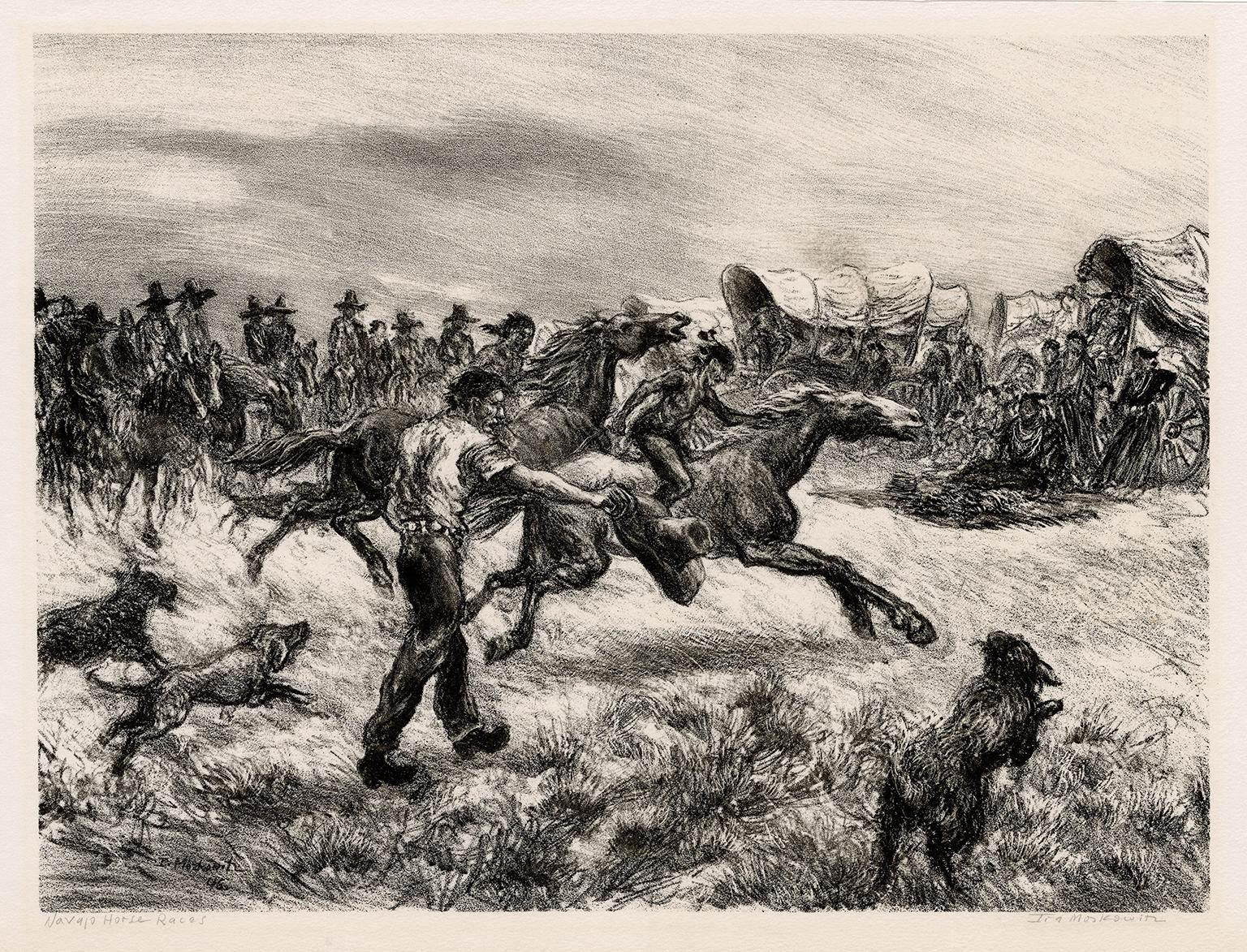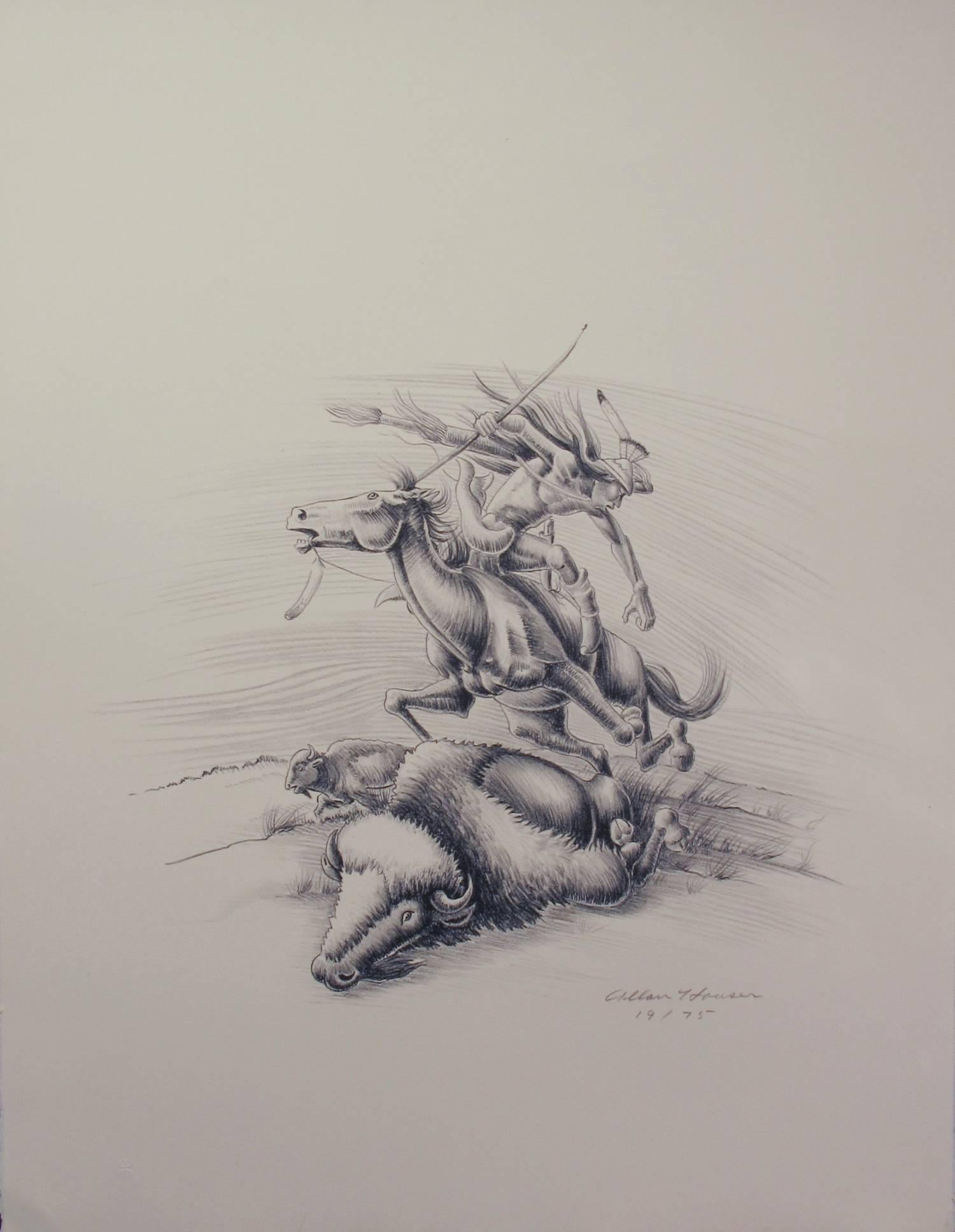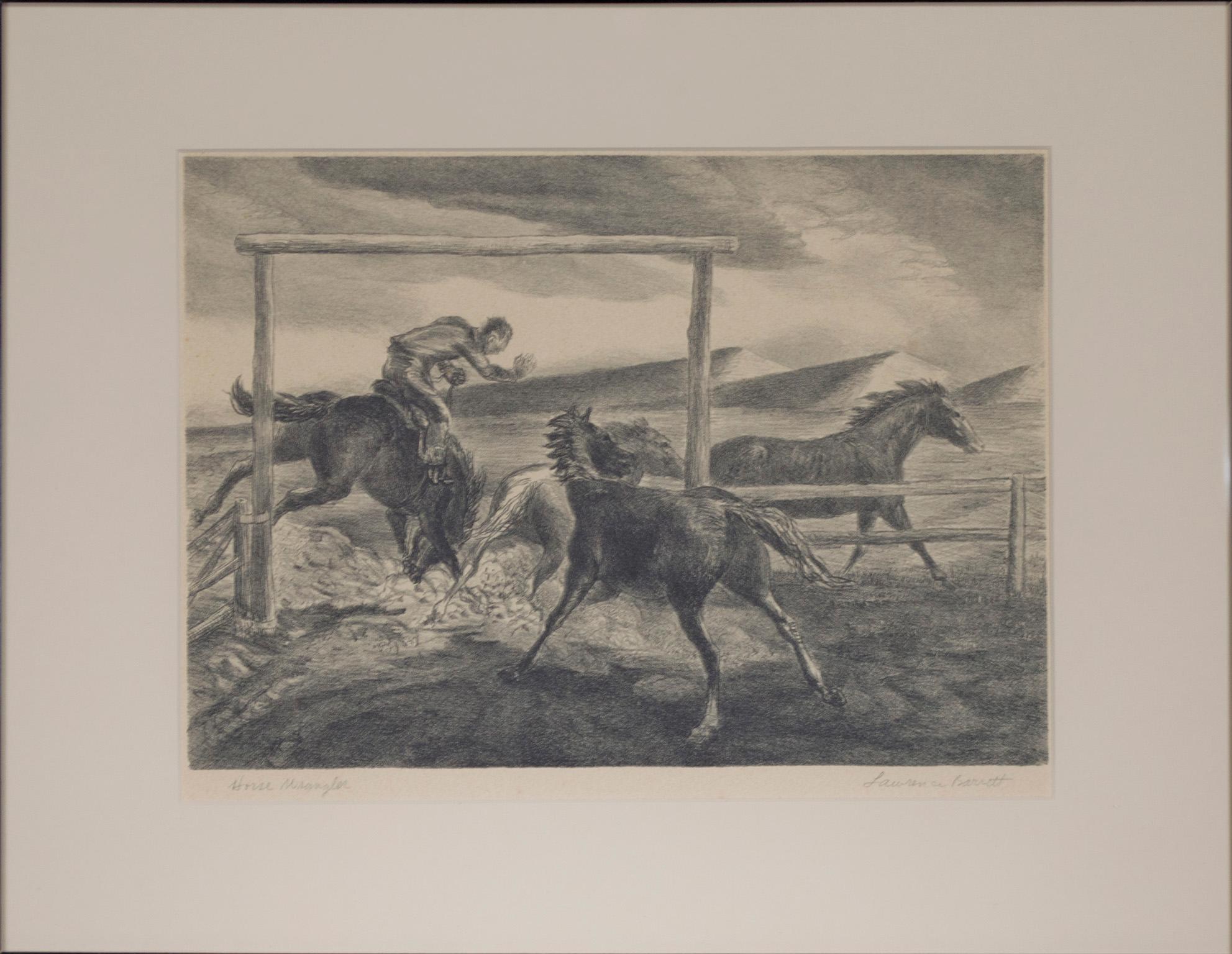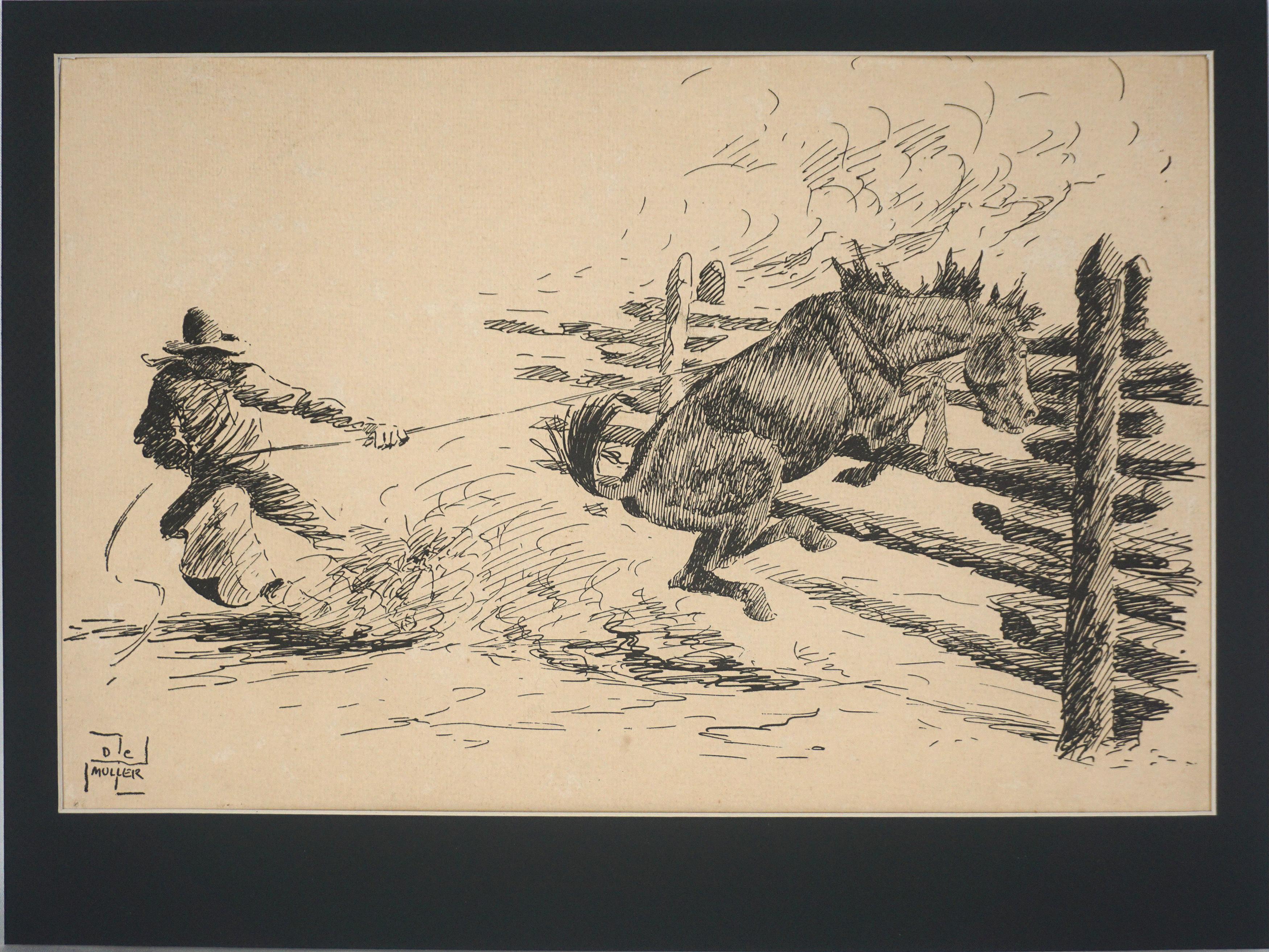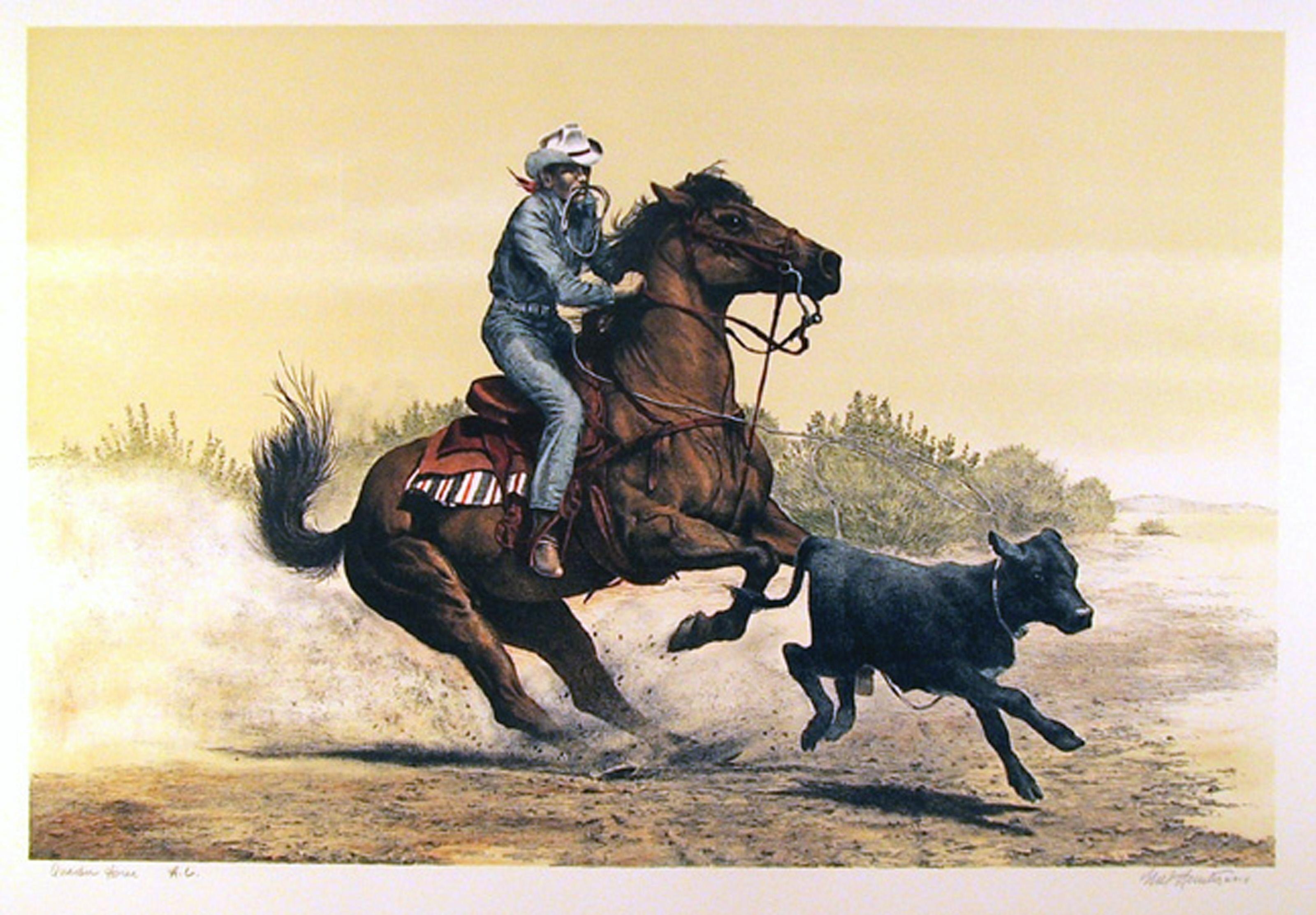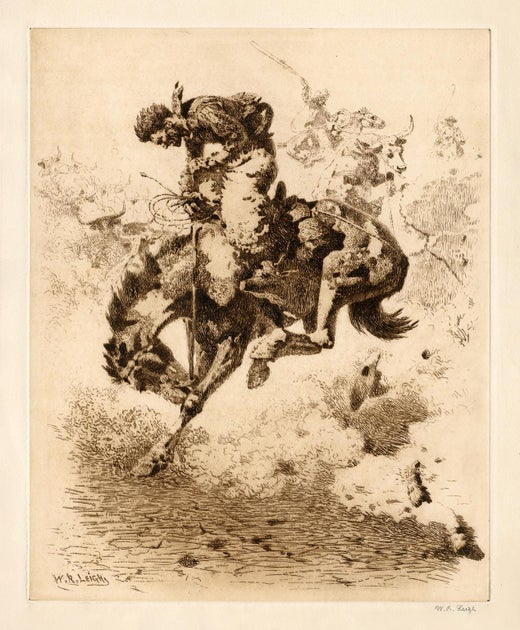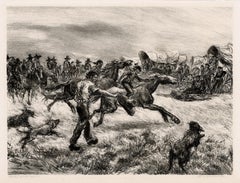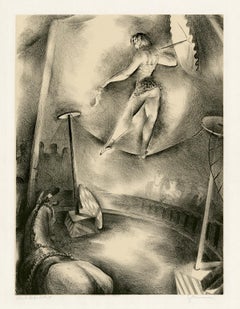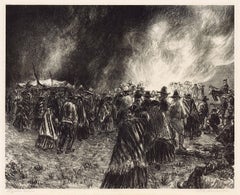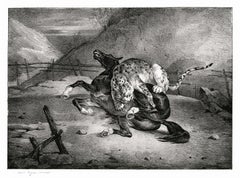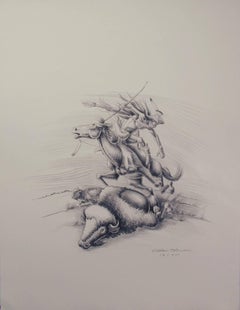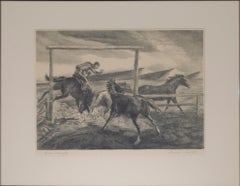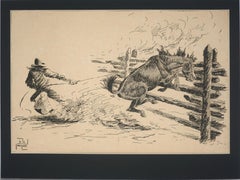Items Similar to 'Foul Rope (Left)' — Early American Southwest Rodeo
Want more images or videos?
Request additional images or videos from the seller
1 of 6
William Robinson Leigh'Foul Rope (Left)' — Early American Southwest Rodeoc. 1920
c. 1920
$5,500
£4,150.70
€4,751.92
CA$7,756.82
A$8,516.02
CHF 4,442.83
MX$103,055.76
NOK 55,683.96
SEK 52,468.93
DKK 35,471.83
About the Item
William Robinson Leigh, 'Foul Rope (Left)', etching, c. 1920, edition unknown but small. Signed in pencil and signed in the plate, lower left. A superb, richly-inked impression, in dark brown ink, on buff wove Umbria paper, the full sheet with margins (1 1/2 to 2 3/4 inches); slight toning at the sheet edges, otherwise in excellent condition. Very scarce. Archivally matted to museum standards, unframed.
Image size 14 7/8 x 11 15/16 inches (378 x 303 mm); sheet size 20 3/8 x 15 3/8 inches (518 x 391 mm).
ABOUT THE ARTIST
Born near Falling Waters, West Virginia, on a plantation a year after the Civil War and raised in Baltimore, William Robinson Leigh (1866 - 1955) became one of the foremost painters of the American West. His career spanning some seventy-five years, Leigh created some of the most iconic depictions of the Western landscape, with admirers referring to him as ‘The Sagebrush Rembrandt.’
The son of impoverished Southern aristocrats, Leigh received his first art training at age 14 from Hugh Newell at the Maryland Institute, where he was regarded as the best student in his class. From 1883 to 1895, he studied in Europe, mainly at the Royal Academy in Munich with Ludwig Loefftz. From 1891 to 1896, he painted six cycloramas or murals in the round, a giant German panorama.
In 1896, Leigh began working as a magazine illustrator for Scribner's and Collier's Weekly Magazine in New York City. He also painted portraits, landscapes, and genre scenes.
Leigh's trips to the Southwest began in 1906 when he agreed to paint the Grand Canyon with William Simpson, Santa Fe Railway advertising manager, in exchange for free transportation West. In 1907, he completed his Grand Canyon painting, which led to more commissions and an extensive painting trip through Arizona and New Mexico. These travels inspired him to paint western subjects for the next 50 years, and his primary interests were the Hopi and Navajo Indians.
In 1910, he traveled to Wyoming, where he painted in Yellowstone Park and created sketches, many of which he later converted into large canvases such as ‘Lower Falls of the Yellowstone’ (1915) and ‘Grand Canyon of the Yellowstone’ (1911).
In 1926, he traveled to Africa at the invitation of Carl Akeley for the American Museum of Natural History, and from this experience, wrote and illustrated 'Frontiers of Enchantment: An Artist's Adventures in Africa'. In 1933, he wrote and illustrated 'The Western Pony'. His adventures were chronicled in several popular magazines, including Life, the Saturday Evening Post, and Colliers.
For many years, Grand Central Art Galleries at the Biltmore Hotel handled his work exclusively in New York. In 1953, Leigh was elected an associate member of the National Academy of Design and became a full Academician in 1955.
In March 1999, the Historical Center of Cody, Wyoming, held an exhibition of his field sketches and finished works depicting his experiences near Cody early in the century. Between 1910 and 1921, when he often painted in the Carter Mountain vicinity, these years were considered pivotal to his artistic development and devotion to the Western landscape.
Leigh's work is held in many museum collections of American Western art, including the American Museum of Natural History, Arizona State University Art Museum, Buffalo Bill Historical Center (WY), Carnegie Museums of Pittsburg, Desert Caballeros Western Museum (AZ), Eiteljorg Museum of American Indians and Western Art (IN), Farnsworth Art Museum (ME), Gilcrease Museum (Tulsa), Heckscher Museum (NY), Jack S Blanton Museum of Art (University of Texas), Joslyn Art Museum (NE), National Cowboy and Western Heritage Museum (OK), National Gallery of Art, National Museum of Wildlife Art (WY), Oklahoma City Museum of Art, Sangre De Cristo Arts Center (CO), Smithsonian American Art Museum, Springville Museum of Art (UT), The Newark Museum, The University of Arizona Museum of Art, and the Witte Museum (TX).
- Creator:William Robinson Leigh (1866 - 1955, American)
- Creation Year:c. 1920
- Dimensions:Height: 14.88 in (37.8 cm)Width: 11.94 in (30.33 cm)Depth: 0.01 in (0.26 mm)
- Medium:
- Movement & Style:
- Period:
- Condition:
- Gallery Location:Myrtle Beach, SC
- Reference Number:Seller: 1038731stDibs: LU53239015112
William Robinson Leigh
William R. Leigh was born in Berkeley County, West Virginia in 1866 and spent his boyhood on a farm. At the age of fourteen he was sent to the Maryland Institute in Baltimore to begin his art training. Although from a very poor family, he managed to spend twelve years in Europe where he studied at the Royal Academy in Munich, Germany. Upon returning to the United States he opened a studio in New York and did illustrations for "Scribner's Magazine". It was not until he was forty years old that he was able to see the West which had occupied his thoughts for such a long time. His bold use of color depicted the clear light and brilliant hues of the West as he saw it. It was during this phase of his career that he came to be known as the "Sagebrush Rembrandt". In 1921 Leigh married Ethel Traphagen, a women's clothing designer, and together they established the successful Traphagen School of Fashion in New York City. In 1926 and 1928 he made two trips to Africa. On these trips he did many paintings of big game, and returning to New York he did the backgrounds for animal habitat groups. He painted in the Southwest nearly every summer between 1912 and 1926. His style was realistic and his palette invariably had the Southwestern hues of soft pinks, reds, yellows and purples. In fact, his critics who knew little of the Southwest accused him of fabricating the colors. He died in 1955.
About the Seller
5.0
Recognized Seller
These prestigious sellers are industry leaders and represent the highest echelon for item quality and design.
Platinum Seller
Premium sellers with a 4.7+ rating and 24-hour response times
Established in 1995
1stDibs seller since 2016
321 sales on 1stDibs
Typical response time: 1 hour
Associations
International Fine Print Dealers Association
- ShippingRetrieving quote...Shipping from: Myrtle Beach, SC
- Return Policy
Authenticity Guarantee
In the unlikely event there’s an issue with an item’s authenticity, contact us within 1 year for a full refund. DetailsMoney-Back Guarantee
If your item is not as described, is damaged in transit, or does not arrive, contact us within 7 days for a full refund. Details24-Hour Cancellation
You have a 24-hour grace period in which to reconsider your purchase, with no questions asked.Vetted Professional Sellers
Our world-class sellers must adhere to strict standards for service and quality, maintaining the integrity of our listings.Price-Match Guarantee
If you find that a seller listed the same item for a lower price elsewhere, we’ll match it.Trusted Global Delivery
Our best-in-class carrier network provides specialized shipping options worldwide, including custom delivery.More From This Seller
View All'Navajo Horse Race' — Southwest Regionalism, American Indian
By Ira Moskowitz
Located in Myrtle Beach, SC
Ira Moskowitz, 'Navajo Horse Race', lithograph, 1946, edition 30, Czestochowski 204. Signed and titled in pencil. Signed and dated in the stone, lower le...
Category
1940s American Modern Landscape Prints
Materials
Lithograph
Slack Rope Artist
By Benton Murdoch Spruance
Located in Myrtle Beach, SC
Benton Spruance, 'Slack Rope Artist', lithograph, 1930, edition 30, Fine and Looney 35. Signed and titled in pencil. Numbered '2' in the bottom right margin. A fine impression, with ...
Category
1930s American Modern Figurative Prints
Materials
Lithograph
'Navajo Courtship Dance' — Southwest Regionalism, American Indian
By Ira Moskowitz
Located in Myrtle Beach, SC
Ira Moskowitz, 'Navajo Courtship Dance (Squaw Dance)', lithograph, 1946, edition 30, Czestochowski 161. Signed and titled in pencil. Signed and dated in the stone, lower left. A fine, richly-inked impression, on cream wove paper; the full sheet with margins (7/16 to 2 3/4 inches). Pale mat line, otherwise in excellent condition. Matted to museum standards, unframed.
Image size 11 13/16 x 14 13/16 inches (300 x 376 mm); sheet size 13 1/16 x 20 1/8 inches (332 x 511 mm).
ABOUT THE ARTIST
Ira Moskowitz was born in Galicia, Poland, in 1912, emigrating with his family to New York in 1927. He enrolled at the Art Student's League and studied there from 1928-31. In 1935, Moskowitz traveled to Paris and then lived until 1937 in what is now Israel. He returned to the United States in 1938 to marry artist Anna Barry in New York. The couple soon visited Taos and Santa Fe in New Mexico, returning for extended periods until 1944, when they moved there permanently, staying until 1949. During this especially productive New Mexico period, Moskowitz received a Guggenheim fellowship. His work was inspired by the New Mexico landscape and the state’s three cultures (American Southwest, Native American, and Mexican). He focused on Pueblo and Navajo life, producing an extensive oeuvre of authentic American Indian imagery. He and Anna also visited and sketched across the border in Old Mexico. While in the Southwest, Moskowitz flourished as a printmaker while continuing to produce oils and watercolors. Over 100 of Moskowitz’s works depicting Native American ceremonies were used to illustrate the book American Indian Ceremonial Dances by John Collier, Crown Publishers, New York, 1972.
After leaving the Southwest, printmaking remained an essential medium for the artist while his focus changed to subject matter celebrating Judaic religious life and customs. These works were well received early on, and Moskowitz was content to stay with them the rest of his life. From 1963 until 1966, Moskowitz lived in Paris, returning to New York City in 1967, where he made his permanent home until he died in 2001.
Shortly before his death, Zaplin-Lampert Gallery of Santa Fe staged an exhibition of the artist's works, December 2000 - January 2001. Other one-person shows included the 8th Street Playhouse, New York, 1934; Houston Museum, 1941; and the San Antonio Museum, 1941. The artist’s work was included in exhibitions at the Art Students League, Art Institute of Chicago, Philadelphia Print Club, College Art Association (promotes excellence in scholarship and teaching), and the International Exhibition of Graphic Arts (shown at MOMA, 1955).
Moskowitz’s lithographs of...
Category
1940s American Modern Landscape Prints
Materials
Lithograph
'Horse Attacked by Tiger' — 19th-Century French Romanticism
By Jean Louis Andre Theodore Gericault
Located in Myrtle Beach, SC
Théodore Géricault (after), 'Tigre dévorant un cheval' (Tiger Devouring a Horse), lithograph, 3rd state of 3, Clement 97, c. 1820. Lettered 'Volmar ...
Category
1820s Romantic Animal Prints
Materials
Lithograph
'Navajo Trading Post' — Southwest Regionalism, American Indian
By Ira Moskowitz
Located in Myrtle Beach, SC
Ira Moskowitz, 'Navajo Trading Post', lithograph, 1946, edition 30, Czestochowski 161. Signed and dated in the stone, lower left. A fine, richly-inked impression, on cream wove paper, with full margins (1 1/2 to 3 1/8 inches). Pale mat line, otherwise in excellent condition. Matted to museum standards, unframed.
Image size 11 11/16 x 15 1/2 inches (297 x 395 mm); sheet size 16 5/16 x 191/8 inches (414 x 486 mm).
ABOUT THE ARTIST
Ira Moskowitz was born in Galicia, Poland, in 1912, emigrating with his family to New York in 1927. He enrolled at the Art Student's League and studied there from 1928-31. In 1935, Moskowitz traveled to Paris and then lived until 1937 in what is now Israel. He returned to the United States in 1938 to marry artist Anna Barry in New York. The couple soon visited Taos and Santa Fe in New Mexico, returning for extended periods until 1944, when they moved there permanently, staying until 1949. During this especially productive New Mexico period, Moskowitz received a Guggenheim fellowship. His work was inspired by the New Mexico landscape and the state’s three cultures (American Southwest, Native American, and Mexican). He focused on Pueblo and Navajo life, producing an extensive oeuvre of authentic American Indian imagery. He and Anna also visited and sketched across the border in Old Mexico. While in the Southwest, Moskowitz flourished as a printmaker while continuing to produce oils and watercolors. Over 100 of Moskowitz’s works depicting Native American ceremonies were used to illustrate the book American Indian Ceremonial Dances by John Collier, Crown Publishers, New York, 1972.
After leaving the Southwest, printmaking remained an essential medium for the artist while his focus changed to subject matter celebrating Judaic religious life and customs. These works were well received early on, and Moskowitz was content to stay with them the rest of his life. From 1963 until 1966, Moskowitz lived in Paris, returning to New York City in 1967, where he made his permanent home until he died in 2001.
Shortly before his death, Zaplin-Lampert Gallery of Santa Fe staged an exhibition of the artist's works, December 2000 - January 2001. Other one-person shows included the 8th Street Playhouse, New York, 1934; Houston Museum, 1941; and the San Antonio Museum, 1941. The artist’s work was included in exhibitions at the Art Students League, Art Institute of Chicago, Philadelphia Print Club, College Art Association (promotes excellence in scholarship and teaching), and the International Exhibition of Graphic Arts (shown at MOMA, 1955).
Moskowitz’s lithographs of American Indian...
Category
1940s American Modern Landscape Prints
Materials
Lithograph
'Old Cedars' – Early New Mexico Landscape, Southwest Regionalism
By George Elbert Burr
Located in Myrtle Beach, SC
George Elbert Burr, 'Old Cedars – New Mexico', etching, 1920, edition 40, Seeber 218. Signed and annotated '(c) George Elbert Burr Del. et Imp.' in pencil. ...
Category
1920s Realist Landscape Prints
Materials
Etching
You May Also Like
Apache Hunter, limited edition lithograph by Allan Houser, horseback hunter
By Allan Houser
Located in Santa Fe, NM
Apache Hunter, limited edition lithograph by Allan Houser, horseback hunter
hand-pulled black and white lithograph
printed in Santa Fe, New Mexico
unframed edition of 75
Allan Houser (Haozous), Chiricahua Apache (1914-1994)
Selected Collections
Centre Georges Pompidou, Paris, France * “They’re Coming”, bronze
Dahlem Museum, Berlin, Germany
Japanese Royal Collection, Tokyo, Japan “The Eagle”, black marble commissioned by President William J. Clinton
United States Mission to the United Nations, New York City, NY *"Offering of the Sacred Pipe”, monumental bronze by Allan Houser © 1979 Presented to the United States Mission to the United Nations as a symbol of World Peace honoring the native people of all tribes in these United States of America on February 27, 1985 by the families of Allan and Anna Marie Houser, George and Thelma Green and Glenn and Sandy Green in New York City.
National Portrait Gallery, Smithsonian, Washington, DC * Portrait of Geronimo, bronze
National Museum of American Art, Smithsonian, Washington, D.C. * “Buffalo Dance Relief”, Indiana limestone
National Museum of the American Indian, Smithsonian, Washington, D.C. *Sacred Rain Arrow, (Originally dedicated at the US Senate Committee on Indian Affairs, US Senate Building) “Goat”, “To The Great Spirit” - dedicated in 1994 at the Vice President’s Residence in Washington, D.C.. Ceremony officiated by Hillary Rodham Clinton and Tipper Gore.
Oklahoma State Capitol, Oklahoma City, Ok * “As Long As the Waters Flow”, bronze
Gilcrease Museum, Tulsa, OK *Sacred Rain Arrow, bronze
Fort Sill, Oklahoma *”Chiricahua Apache Family”, bronze Donated and dedicated to Allan Houser’s parents Sam and Blossom Haozous by Allan Houser and Glenn and Sandy Green
The Heard Museum, Phoenix, Arizona *Earth Song, marble donated by Glenn and Sandy Green
The Clinton Presidential Library, Arkansas * “May We Have Peace”, bronze
The George H.W. Bush Presidential Library, College Station, Texas *"Offering to the Great Spirit", bronze
The British Royal Collection, London, England *Princess Anne received "Proud Mother", bronze in Santa Fe
Allan Houser’s father Sam Haozous, surrendered at the age of 14 with Geronimo and his band of Warm Springs Chiricahua Apache people in 1886 in Southern Arizona. This was the last active war party in the United States.
This group of Apache people was imprisoned for 27 years starting in Fort Marion, Florida and finally living in captivity in Fort Sill, Oklahoma.
Allan Houser was born in 1914.
His artwork is an ongoing testimony to Native life in America – its beauty, strength and poignancy. Allan Houser is from the culture and portrayed his people in an insightful and authentic way. Because of the era in which he lived, he had a rare understanding of American Indian life. Allan was the first child born after the Chiricahua Apaches were released from 27 years of captivity. Allan grew up speaking the Chiricahua dialect. Allan heard his father’s stories of being on the warpath with Geronimo and almost nightly heard his parents singing traditional Apache music. Allan’s father knew all of Geronimo’s medicine songs.
Allan had an early inclination to be artistic. He was exposed to many Apache ceremonial art forms: music, musical instruments, special dress, beadwork, body painting and dynamic dance that are integral aspects of his culture. His neighbors were members of many different tribes who lived in Oklahoma. Allan eagerly gained information about them and their cultures. Allan gathered this information and mentally stored images until he brought them back to life, years later, as a mature artist.
Allan Houser was represented by Glenn Green Galleries (formerly known as The Gallery Wall, Inc.) from 1973 until his death in 1994. The gallery served as agents, advocates, and investors during this time.
In 1973 the Greens responded enthusiastically to the abstraction and creativity in Houser’s work. They were impressed, not only with his versatility and talent but with the number of mediums he employed. His subject matter was portrayed in styles ranging from realism, stylized form to abstraction.
With encouragement from the Greens, Houser at the age of 61, retired from his post as the head of the sculpture department at the Institute of American Indian Arts in Santa Fe, New Mexico in 1975 to begin working full-time creating his art. The next 20-year period was an exciting time for Allan, the gallery, and for the Green family. He created a large body of sculpture in stone, wood and bronze. For many years Glenn Green Galleries co-sponsored many editions of his bronzes and acted as quality control for the bronze sculptures according to Houser’s wishes.
As both agents and gallery representatives, the Greens promoted and sold his art in their galleries in Phoenix and Scottsdale, Arizona and in Santa Fe, New Mexico. They had bi-annual exhibits in their galleries to feature Houser’s newest work and sponsored and arranged international museum shows in America, Europe and Asia. They travelled for these events including a trip to Carrara, Italy to the famed quarries of Michelangelo and together co-financed and arranged the purchase of 20 tons of marble.
A watershed event for Allan Houser’s career occurred in the early 1980’s when Glenn Green Galleries arranged with the US Information Agency a touring exhibit of his sculpture through Europe. This series of exhibits drew record attendance for these museums and exposed Houser’s work to an enthusiastic art audience. This resulted in changing the perception of contemporary Native art in the United States where Houser and Glenn Green Galleries initially faced resistance from institutions who wanted to categorize him in a regional way. The credits from the European exhibits helped open doors and minds of the mainstream art community in the United States and beyond.
Senator Daniel Inouye of Hawaii was a supporter of Allan Houser’s artwork. We worked with Senator Inouye on many occasions hosting events at our gallery and in Washington D.C in support of the formation of the Smithsonian’s National Museum of the American Indian in Washington, D.C. and other causes supporting Native Americans.
Allan Houser is shown below presenting his sculpture “Swift Messenger” to Senator Inouye in Washington, D.C.. This sculpture was eventually given to the National Museum of the American Indian, Smithsonian’s permanent collection. It is now currently on loan and on display in the Oval Office. President Biden’s selection of artwork continues our gallery’s and Allan’s connection to the White House from our time working with Allan Houser from 1974 until his passing in 1994.
“It was important for President Biden to walk into an Oval that looked like America and started to show the landscape of who he is going to be as president,” Ashley Williams...
Category
1970s Contemporary Figurative Prints
Materials
Lithograph
"Horse Wrangler, " Original Black & White Lithograph by Lawrence Barrett
By Lawrence Barrett
Located in Milwaukee, WI
"Horse Wrangler" is an original lithograph by the artist Lawrence Barrett signed in the lower right hand corner. Four beautifully drawn horses use a moment of commotion to escape a corral. Low hills and an expansive sky serve as a background.
Image: 8.75" x 12.25"
Framed: 11.9" x 16.5"
Lawrence Barrett was an etcher, lithographer, teacher, illustrator, sculptor, writer, and painter. Born in Guthrie, Oklahoma, Barrett was a student at the Broadmoor Academy...
Category
Early 20th Century Realist Figurative Prints
Materials
Lithograph
"Roy Matthews Calf Roping" Famous 1930s/40s Rodeo Rider
Located in San Antonio, TX
Pepper Brown
(1926-1999)
Alpine Artist
Image Size: 9 x 13
Frame Size: 15 x 18.75
Medium: Ink Drawing
Dated 1942
"Roy Matthews Calf Roping"
Category
1940s Impressionist Animal Drawings and Watercolors
Materials
Ink
Original Mid Century Western Pen and Ink "Cowboy and Bronco"
Located in Soquel, CA
Original Mid Century Pen and Ink on Paper "Cowboy and Bronco" Western Genre
Compelling pen and ink western picture of Cowboy wrangling the bro...
Category
1950s American Realist Figurative Paintings
Materials
India Ink, Laid Paper
$2,000 Sale Price
20% Off
Quarter Horse, American Realist Lithograph by Mel Hunter
By Mel Hunter
Located in Long Island City, NY
Mel Hunter, American (1927 - 2004) - Quarter Horse, Year: 1974, Medium: Lithograph, signed and numbered in pencil, Edition: 500, Size: 22 in. x 29.5 in. (55.88 cm x 74.93 cm), De...
Category
1970s American Realist Animal Prints
Materials
Lithograph
"Boots Mansfield Calf Roping" Tie- Down Roping World Champion
Located in San Antonio, TX
Pepper Brown
(1926-1999)
Alpine Artist
Image Size: 9.5 x 9.25
Frame Size: 15.5 x 19
Medium: Ink Drawing
Dated 1942
"Boots Mansfield Calf Roping" Tie- Dow...
Category
1940s Impressionist Animal Drawings and Watercolors
Materials
Ink
